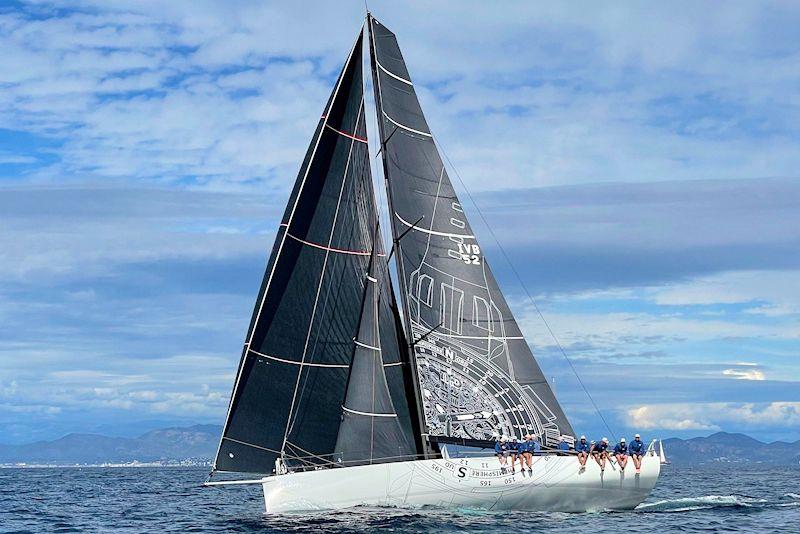
Evolution of the IRC code zero - A conversation with North Sails
by Calanach Finlayson 2 Dec 2022 09:00 GMT

Evolution of the IRC code zero © Ronan Grealish
In our previous article we spoke with Ronan Grealish from North Sails on the topic of reaching sail configurations for double-handed racing. In this article we continue the conversation to take a closer look at the design philosophy and evolution of the code zero. Modern top-down furling code zeros such as those from North have come a long way since the traditional flappy leech sails of late.
Defining code zero
Under the IRC rating rule, the definition of a spinnaker stipulates it must have a half width 'equal to or greater than 75% of foot length'. Further definitions exist for Headsail and Flying Headsail both of which carry their own rating penalty based on sail area. There is no specific definition for a code zero, so to avoid rating as a very large jib, sailmakers instead design these to meet the 75% mid-girth requirement of a spinnaker.
This means that as long as the area of the code zero is less than the largest spinnaker, it does not automatically incur a rating hit.
The flappy leech
By making a code zero rate as a spinnaker, sailmakers are pushed down a design path where the rule requirements don't necessarily align with the pure performance goal for the sail. As a result, IRC code zeros have had to carry the burden of unwanted extra material at the mid-girth, giving them that familiar flappy leech. Pointing ability with these sails requires the halyard or tack line to be cranked on hard.
"Historically we would have hung the sail off quite a highly loaded cable. You are essentially trying to make the front of your code zero like your forestay. Then the excess cloth that is in that sail in order to meet the rule requirements is hanging off the back. That sail is really nice when you are fully sheeted on and you have control over the leech with a tweaker but you are always balancing the fine line between not stalling the sail and keeping the leech under control.
"As the luff sags to leeward, the leech stands up proud and returns into the main. So anything you can do get the front of the sail to be closer to the wind, and more projected, means the leech opens up and gives you more forward progression," says Ronan.
Advancements in construction
Thanks to improvements in materials and manufacturing techniques, sailmakers are now able to build code zeros which no longer rely on cable tension to get the luff to project. "The mindset has changed from a design perspective, where we are now trying to take some of that excess cloth from the back of the sail and push it towards the luff.
"As we have learned more about sail construction and load sharing, we can get the sail to project similar to how a spinnaker does when you ease the sheet downwind. The structure of the sail doesn't have to hang off the cable, the cable is primarily there for ease of handing and not as a primary structural element."
Load sharing for top-down furling
Load sharing refers to how much of the luff load is carried by the sail compared to the cable. North Helix code zeros feature a thin torsional cable inside a luff pocket for top-down furling. The cable has to be 'pre-charged' to begin furling, which essentially means winding the cable multiple times like an elastic band until the torsional force is enough to initiate the furl at the head. Getting the correct load share is critical to success.
Depending on the sail material, style and usage, the load share can vary significantly from 80/20 one way (with the sail taking 80% of the load), to 30/70 the other way. While modern sail constructions may be capable of carrying a higher load share than previously, there is a danger to pushing this too far. Just like an elastic band in a toy aeroplane, a slack cable is liable to bind up on itself when the torsion load reaches a certain point so there is an important balance to be struck.
"We are always setting it up in such a way that the cable is able to do its job effectively, while also allowing the sail to do its job of projecting the luff".
Conclusion
The IRC code zero is very much a product of the rating rule. Sail designers have to find a way to deal with the excess material required to meet the definition of a spinnaker. Traditionally this was achieved by adding extra cloth to the leech which much of the time flogs redundantly in the breeze.
New materials and construction techniques have allowed for this extra material to be re-distributed in the sail to reduce the flapping and instead help the luff to project.
A key component of this new philosophy is the move to a thin, lightweight, top-down furling cable. These systems produce much tighter furls if setup correctly but getting the load share between the sail and the cable can make the difference between success or disaster.
If you have any questions then please feel free to contact us at or click the link below to see our full range of code zero furlers:
